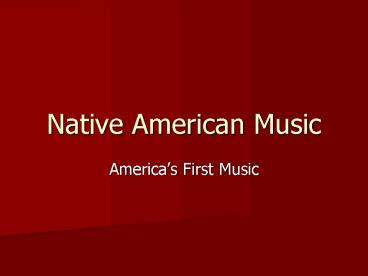Native American Music - PowerPoint PPT Presentation
1 / 20
Title:
Native American Music
Description:
Native American Music America s First Music Listening Listen to, describe and analyze Native American music. War Dance Song of Southern Plains Indians What are your ... – PowerPoint PPT presentation
Number of Views:145
Avg rating:3.0/5.0
Title: Native American Music
1
Native American Music
- Americas First Music
2
Listening
- Listen to, describe and analyze Native American
music.War Dance Song of Southern Plains Indians - What are your first impressions?
- Does this music sound improvised (made up on the
spot) or memorized? - Does this music sound like it has patterns of
form? Explain.
3
Discussion
- Pretend that you are coming to America for the
first time from another country. You encounter
the Indians in a tribal ceremony and hear their
music for the first time. How do you think you
would describe the music? The Natives?
4
Map of Regions
5
The Beginnings
- Native Americans trace the ultimate origin of
their traditional music to the time of creation,
when specific songs were given to the first
people by a Creator and by spirit beings in the
mythic past. - Sacred narratives describe the origins of
specific musical instruments, songs, dances, and
ceremonies.
6
Its Purpose
- They judged the worth of their music making by
its ability to serve specific functions, not by
aesthetics, as Europeans tend to do.
7
Characteristics
- Vocal texture monophonic one voice or a
number of voices in unison, except for drones. - Instruments Rattles and sticks, drums with skin
heads, whistles and flutes - Forms brief repeated melodic phrases, form
shaped by ceremony
8
Southwest Region
9
Southwest Region Music Characteristics
- idiophones and aerophones as mediums to sound
production beginning date in the seventh century.
- Sing in Plains-style nasal vocals with unblended
monophony - http//www.youtube.com/watch?vWuJAToguCiU
- Describe the music you hear.
10
Eastern Woodlands
11
Eastern Woodlands
- antiphony (call and response style singing),
which does not occur in other areas. - Their territory includes Maritime Canada, New
England, U.S. Mid-Atlantic, Great Lakes and
Southeast regions.
12
Eastern Woodlands
- Songs are rhythmically complex, characterized by
frequent metric changes and a close relationship
to ritual dance. - Flutes and whistles are solo instruments, and a
wide variety of drums, rattles and striking
sticks are played.
13
Plains
- Plains-area music is nasal, with high pitches and
frequent falsettos, with a terraced descent (a
step-by-step descent down an octave) in an
unblended monophony
14
Plains
- Large double-sided skin drums are characteristic
of the Plains tribes, and solo end-blown flutes
(flageolet) are also common.
15
Great Basin
- Music of the Great Basin is simple, discreet and
ornate, characterized by short melodies with a
range smaller than an octave, moderately-blended
monophony, relaxed and open vocals
16
Northwest Coast
- Open vocals with monophony are common in the
Pacific Northwest and British Columbia, though
polyphony also occurs (this the only area of
North America with native polyphony).
17
Arctic
- The Inuit of Alaska, Northwest Territories, Yukon
Territory, Nunavut and Greenland are well-known
for their throat-singing, an unusual method of
vocalizing found only in a few cultures
worldwide. - http//www.youtube.com/watch?vqnGM0BlA95I
18
Describe what you hear
- Listen to the following music. Describe the
- Vocals
- Rhythms
- The structure
19
Describe what you hear part 2
- Listen to and see the following clip. Simply
describe what you hear and see. - http//www.youtube.com/watch?vVRCpLtlZ8Hcfeature
related
20
Compare and Contrast
- In one paragraph, compare and contrast the
contemporary Native American Music with
traditional Native American music. - Song 1
- Song 2
- Contemporary Native American Music How would
you describe it? - http//www.youtube.com/watch?vnp0f3YbCymw































